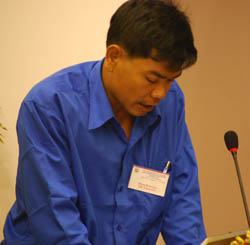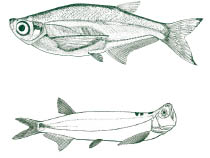From anarchy to harmony: fisheries in transition
as reforms spread
A Cambodian village on the border with Viet Nam reaps early benefits from its newly-established community fisheries. But longer term challenges remain.

Mr Meng Monorom, the Phoum Khsach Community
Fisheries chief
Photo: Lem Chamnap
| Hundreds of thousands community members now run former fishing lots |
| Over the past nine years, the government has released more than half a million hectares of fishing lot areas to local communities across Cambodia.. Previously auctioned off to private bidders, these fishing grounds are now used for family subsistence According to a report delivered by Agriculture, Forestry and Fisheries Minister Chan Sarun. the country now has 468 community fisheries of which 433 are involved in inland fisheries. Speaking at the National Fish Day ceremony in Kep on July 1, the minister said the latest figures showed that community fisheries had 227,044 members spread across 126, 390 households. At the same time, he said, the ministry had promoted the establishment of 229 community fisheries conservation areas. |
Ten years ago, Prime Minister Hun Sen acknowledged that escalating social conflicts over fishing rights had created "anarchy in fisheries" in Cambodia. Since then, the government has released 56% of the area covered by state-owned fishing lots to local communities under a series of reforms which have evolved into the current system of community management launched in 2005. Although many "closed" fishing lots remain in Cambodia, especially on the highly-productive fishing grounds of the Tone Sap Lake, the lots released have effectively been abolished and are no longer leased out to the highest bidders who previously enjoyed private access and exclusive fishing rights.
Among the many fishing grounds that went from private to public and ultimately community hands over the past decade is former Fishing Lot No 17 in Prey Veng province, one of the country's poorest provinces. Located in Kah Samoeuv commune in Peam Chor district near the border with Viet Nam, these fishing grounds stretch across 3,133 ha. Although still stateowned, they are now governed by a body known as the Phoum Khsach Community Fisheries (CF). Set up in 2008 with help from the Fisheries Administration and the Fisheries Management and Governance component of the MRC Fisheries Programmme, the Community Fisheries has 306 members including 64 women. According to Mr Meng Monorom, the Phoum Khsach Community Fisheries chief, one of the first steps taken in setting up the new body was to raise awareness of the government's Community Fisheries management policy among the 531 households in Khsach and Toul Sang village. Interested villagers then registered to become members, by-laws and regulations were drafted and elections were held from among nine candidates. Five of the candidates were elected to form a Community Fisheries Committee (CFC) which then distributed the by-laws and regulations to villagers and began preparing a map of the Community Fisheries to be signed by commune, district, provincial and national authorities. Work also started on a Fishing Area Agreement (to be signed by the Community Fisheries chief and chief of Prey Veng Fisheries Administration Cantonment) and a Management Plan (to be signed by the Community Fisheries chief, the local commune chief and the director general of the Fisheries Administration). The three-year management plan included establishing a fish sanctuary, stopping the use of illegal fishing gear and protecting the fisheries domain. The plan also included the creation of alternative livelihoods to sustain local fishery resources and alleviate poverty.
Catches increasing as Illegal fishing declines
Speaking at the annual meeting of the MRC Fisheries Programme
in Siem Reap in June, Mr Meng Monorom said the Community Fisheries
had been operating for more than a year and now had its own
patrol groups with regular schedules. Members have cooperated
with fisheries officers in 34 cases of illegal fishing and have
twice distributed information about the community fishery to
neighbouring Vietnamese fishermen. Moreover, cases of illegal
fishing and conflicts with non-members and outsiders are declining.
"People now understand the importance of taking part in
our fisheries resource management," the Community Fisheries
chief told the meeting. "Since having the Community Fisheries
in our villages, we generally see that illegal fishing and conflicts
have notably decreased and that the fish catch has increased
so people are happy." So too, it would seem, are the fish-as
part of conservation efforts, a half-hectare fish sanctuary
has been established around a deep pool.
Among future challenges, Mr Meng Monorom said that demarcating the Community Fisheries boundary with concrete poles was an urgent priority. He also highlighted the need to strengthen compliance though continued distribution of by-laws, regulations and related material and expressed a desire to share experiences with other Community Fisheries. Other challenges included solving trans-boundary issues with Vietnamese fishermen, replanting flooded forest areas, strengthening patrol groups and creating alternative livelihoods to generate funds for the Community Fisheries and its members to help reduce overfishing and alleviate poverty. At the moment, he said, about 85% of the villagers in Khsach and Toul Sang villages rely on fishery resources for their livelihoods.
The Cambodian government seems to be under no illusion that its policy for Community Fisheries management-embodied in a sub-decree issued by the prime minister in 2005-is a magic solution to all challenges faced by the fisheries sector. A policy paper published in 2006 by the then Department of Fisheries noted that "the transition to new forms of rights is always accompanied by fresh conflicts, new alliances, windows of opportunity and a variety of threats. In Cambodia's transition to Community Fisheries, many of these possibilities are likely to emerge."
Further reading
Kurien, J, So N. and Mao S.O. (2006) Cambodia's Aquarian Reforms: the Emerging Challenges for Policy and Research, Inland Fisheries Research and Development Institute, Phnom Penh, Cambodia, 32 pp

| Correction |
| In the last issue of Catch and Culture (Vol 15, No 1), we identified a fish on the second page of the special insert on Thai freshwater aquariums as an Indo-Pacific tarpon (Megalops cypriniodes). In fact, the fish pictured is a species of sorubim (genus Pseudoplatystoma) from the long-whiskered catfish family (Pimelodidae) native to South America. Sorubim is also a popular game fish in Thailand. |
Choose a newsletter: